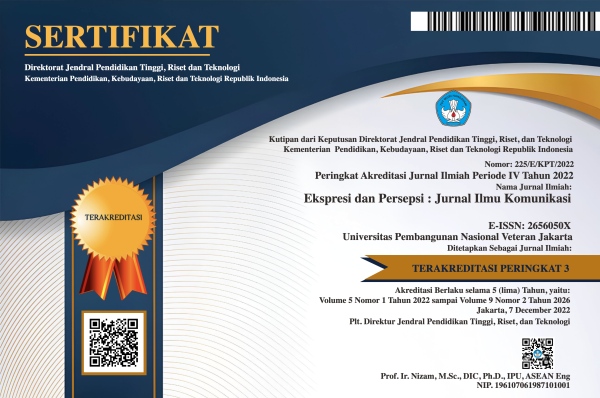Sexuality, Virginity and Disability: Analyzing the Movie Why Do You Love Me (2023)
DOI:
https://doi.org/10.33822/jep.v7i3.8235Keywords:
sexuality, virginity, people with disabilities, multimodal critical discourse analysis, cripping upAbstract
Some research indicates that sexuality and disability are two taboo concepts that are rarely combined. Individuals with disabilities are often portrayed as asexual or hypersexual. The film Why Do You Love Me (2023) attempts to break these stereotypes and depicts sexuality as a symbol of empowerment through the story of three friends with disabilities embarking on a journey to lose their virginity. This study aims to analyze how the film portrays sexuality and virginity of individuals with disabilities. Using a qualitative approach, the research uses critical disability theory and multimodal discourse analysis with critical standpoint to identify dialogues and scenes in the film related to dominant ideologies and accuracy in disability representation. Despite raising a unique theme and diversifying the representation of individuals with disabilities in mainstream media, the results reveal that the practice of “cripping up” perpetuates dominant perspectives and diction in the film’s lexical and visual elements. It uses sexuality and virginity as selling points to determine the social status of men with disabilities amidst societal norms of masculinity. Humor and cinematographic techniques still employ ableist discourses, suggesting the need of men with disabilities for accommodation from the dominant group. Insights for altering cinematic representations of disabilities are explored.
References
Anggraeni, D. M., & Sukmono, F. G. (2019). Representasi Kelompok Minoritas Disabilitas Netra Dalam Film Dokumenter The Unseen Words. Jurnal Interaksi, 3(2), 180–199. https://jurnal.umsu.ac.id/index.php/interaksi/article/view/3355/0
Arawindha, U., Thohari, S., & Fitrianita, T. (2020). Representasi Disabilitas Dalam Film Indonesia yang Diproduksi Pasca Orde Baru. Jurnal Kajian Ruang Sosial-Budaya, 4(1), 133–151. https://doi.org/10.21776/ub.sosiologi.jkrsb.2020.004.1.09
Babbiotti, P., & Hernández-Gil, I. (2021). Color and Meaning in Film: An Argument from Irony. Journal of Comparative Literature and Aesthetics, 44(3). https://jcla.in/wp- content/uploads/2022/03/JCLA-Vol.-44-No.-3-2021_Paolo-Babbiotti-and-Isabel- Hernandez-Gil.pdf
Bappenas. (2021). Kajian Disabilitas: Tinjauan Peningkatan Akses dan Taraf Hidup Penyandang Disabilitas Indonesia: Aspek Sosioekonomi dan Yuridis. Staf Ahli Menteri Bidang Sosial dan Penanggulangan Kemiskinan, Kementerian PPN/Bappenas.
Baranowski, A. M., & Hecht, H. (2018). Effect of Camera Angle on Perception of Trust and Attractiveness. Empirical Studies of the Arts, 36(1), 90–100. https://doi.org/10.1177/0276237417710762
Botha, S., & Harvey, C. (2024). Disabling discourses: contemporary cinematic representations of acquired physical disability. Disability and Society, 39(1), 62–84. https://doi.org/10.1080/09687599.2022.2060801
Carter-Long, L. (2019). Where Have You Gone, Stephen Dwoskin? On Disability Film. Quarterly, 72(3), 26–29. https://doi.org/10.2307/26607499
Cuelenaere, E., Willems, G., & Joye, S. (2019). Remaking identities and stereotypes: How film remakes transform and reinforce nationality, disability, and gender. European Journal of Cultural Studies, 22(5–6), 613–629. https://doi.org/10.1177/1367549418821850
Damayanti, E., & Sevilla, V. (2024). Menyingkap Trauma Pelecehan Seksual terhadap Laki-laki pada Film Dear David. EKSPRESI DAN PERSEPSI : JURNAL ILMU KOMUNIKASI, 7(2), 435– 451. https://doi.org/10.33822/jep.v7i2.7559
Davies, A., Maich, K., Belcher, C., Cagulada, E., DeWelles, M., & van Rhijn, T. (2022). A critical examination of the intersection of sexuality and disability in Special, a Netflix series. In M. S. Jeffress (Ed.), Interdisciplinary Disability Studies: Disability Representation in Film, TV, and Print Media (pp. 44–64). Routledge.
Ebrahim, S. (2019). Disability Porn: The Fetishisation and Liberation of Disabled Sex. In Diverse Voices of Disabled Sexualities in the Global South (pp. 77–99). Springer International Publishing. https://doi.org/10.1007/978-3-319-78852-4_6
Ellcessor, E., & Kirkpatrick, B. (2019). Studying Disability for a Better Cinema and Media Studies. JCMS: Journal of Cinema and Media Studies, 58(4), 139–144. https://doi.org/10.1353/cj.2019.0043
Fleming, C., & Davis, S. N. (2018). Masculinity and Virgin-Shaming Among College Men. Journal of Men’s Studies, 26(3), 227–246. https://doi.org/10.1177/1060826518758974
Gillies, J. (2024). Critical Disability Theory. In F. Maggino (Ed.), Encyclopedia of Quality of Life and Well-Being Research (2nd Ed.). Springer.
Greenberg, S. (2022). The General Audience Talks Back: Code of The Freaks and The Evolution of Hollywood Shaming Documentaries. Film Quarterly, 76(2), 31–38. https://doi.org/10.1525/FQ.2022.76.2.31
Hall, M. C. (2019). Critical Disability Theory (Stanford Encyclopedia of Philosophy). https://plato.stanford.edu/entries/disability-critical/
Hermawan, B. (2021). Analisis Wacana Multimodal untuk Pemula. UPI Press.
Himawan, K. K. (2019). Either I do or I must: An exploration of the marriage attitudes of Indonesian singles. Social Science Journal, 56(2), 220–227.
https://doi.org/10.1016/j.soscij.2018.07.007
Himawan, K. K., Underwood, M., Bambling, M., & Edirippulige, S. (2022). Being single when
marriage is the norm: Internet use and the well-being of never-married adults in Indonesia. Current Psychology, 41(12), 8850–8861. https://doi.org/10.1007/s12144-021- 01367-6
Hu, T., Cottingham, M., Shapiro, D., & Lee, D. (2023). Promote the “wow”: (mis)representation, perception and reception of media promotion on wheelchair rugby. International Journal of Sports Marketing and Sponsorship, 24(3), 470–484. https://doi.org/10.1108/IJSMS- 03-2022-0060
Kim, D., Cho, Y., & Park, K. S. (2018). Comparative analysis of affective and physiological responses to emotional movies. Human-Centric Computing and Information Sciences, 8(1). https://doi.org/10.1186/s13673-018-0138-5
Kim, E. (2010). “A Man, with the Same Feelings”: Disability, Humanity, and Heterosexual Apparatus in Breaking the Waves, Born on the Fourth of July, Breathing Lessons, and Oasis. In S. Chivers & N. Markotić (Eds.), The Problem Body: Projecting Disability on Film (pp. 131–157). Ohio State University Press. http://www.jstor.org/stable/j.ctt1kgqwc5.12
Lane, D. (2019). Presuming Competence: An Examination of Ableism in Film and Television. [Bachelor’s Thesis, The Florida State University]. https://diginole.lib.fsu.edu/islandora/object/fsu:662273
Lee, G. (2021, December 28). The problem with “cripping up” and why casting disabled actors matters - ABC News. https://www.abc.net.au/news/2021-12-28/cripping-up-and-why- casting-disabled-matters/100705512
Loeser, C., Pini, B., & Crowley, V. (2018). Disability and sexuality: Desires and pleasures. Sexualities, 21(3), 255–270. https://doi.org/10.1177/1363460716688682
Machin, D., & Mayr, A. (2012). How to Do Critical Discourse Analysis: A Multimodal Introduction. SAGE Publications.
Malinowska, A. (2018). Lost in representation: Disabled sex and the aesthetics of the ‘norm.’ Sexualities, 21(3), 364–378. https://doi.org/10.1177/1363460716688678
Maria Borges, S. V., Marta, R. F., Panggabean, H. R. G., Briandana, R., & Chinmi, M. (2024). Stereotip dan Prasangka Komunikasi antar Pemeran Film Kos-Kosan dengan Perspektif Wacana Kritis Mills. EKSPRESI DAN PERSEPSI : JURNAL ILMU KOMUNIKASI, 7(2), 421–
https://doi.org/10.33822/jep.v7i2.7236
Marrone, M., Seethaler, I., & Terranova, A. (2019). Grab ’ em by the Pussy: How Hegemonic
Masculinity Encourages Locker Room Talk and Sexual Violence against Women Recommended Citation [Coastal Carolina University]. https://digitalcommons.coastal.edu/honors-theses
McRuer, R. (2019). In Focus: Cripping Cinema and Media Studies: Introduction. JCMS: Journal of Cinema and Media Studies, 58(4), 134–139. https://doi.org/10.1353/cj.2019.0042
Mondal, A. (2023, October 27). ‘Why Do You Love Me’ (2023) Netflix Movie Review - A Heartfelt and Hilarious Road Trip Comedy | Midgard Times. https://moviesr.net/p-why-do-you- love-me-2023-netflix-movie-review-a-heartfelt-and-hilarious-road-trip-comedy
Novianto, H. (Director). (2023). Why Do You Love Me [Video recording]. Max Pictures.
Nurani, N. F. (2020). Analisis Wacana Kritis Penyandang Disabilitas dalam Film Dancing In The Rain. Jurnal Komunika: Jurnal Komunikasi, Media Dan Informatika, 9(2), 84.
https://doi.org/10.31504/komunika.v9i2.3064
Palit, M., & Allen, K. R. (2019). Making meaning of the virginity experience: young men’s
perceptions in the United States. Sexual and Relationship Therapy, 34(2), 137–152.
https://doi.org/10.1080/14681994.2016.1237771
Pazda, A. D., Elliot, A. J., & Greitemeyer, T. (2012). Sexy red: Perceived sexual receptivity
mediates the red-attraction relation in men viewing woman. Journal of Experimental
Social Psychology, 48(3), 787–790. https://doi.org/10.1016/j.jesp.2011.12.009
Pratama, F. N. P., & Alfikri, M. (2022). Representasi Peran Disabilitas Dalam Film Horor Pengabdi Setan 2017 Karya Joko Anwar (Pendekatan Komunikasi Non-Verbal). Journal of Biology Education, Science, & Technology, 5(2), 422–427.
https://doi.org/https://doi.org/10.30743/best.v5i2.6100
Reddy, R., Sharma, A. K., & Jha, M. (2019). Hegemonic masculinity or masculine domination:
Toward a comprehensive social theory of gender. International Journal of Sociology and
Social Policy, 39(3–4), 296–310. https://doi.org/10.1108/IJSSP-08-2018-0133 Rozengarten, T. (2020). Gendered Disabilities: Silent performatives in cinema [Doctoral Dissertation, Flinders University]. https://flex.flinders.edu.au/file/c05b1ccc-1c69-4130-
f9-740d198c27e9/1/RozengartenThesis2020_LibraryCopy.pdf
Sandahl, C. (2019). It’s All the Same Movie: Making Code of the Freaks. JCMS: Journal of Cinema
and Media Studies, 58(4), 145–150. https://doi.org/10.1353/cj.2019.0044
Supanji, T. H. (2023, June 15). Pemerintah Penuhi Hak Penyandang Disabilitas di Indonesia | Kementerian Koordinator Bidang Pembangunan Manusia dan Kebudayaan.
https://www.kemenkopmk.go.id/pemerintah-penuhi-hak-penyandang-disabilitas-di-
indonesia
Sutton, T. (2014). Avenging the Body. In A Companion to the Horror Film (pp. 73–89). Wiley.
https://doi.org/10.1002/9781118883648.ch5
Syarifah, F. (2021, August 10). Studi Nielsen Sebut Film Menyangkut Disabilitas Kurang
Melibatkan Penyandangnya
- Disabilitas Liputan6.com. https://www.liputan6.com/disabilitas/read/4628120/studi-nielsen-sebut-film-
menyangkut-disabilitas-kurang-melibatkan-penyandangnya
Treacy, A. C., Taylor, S. S., & Abernathy, T. V. (2018). Sexual Health Education for Individuals
with Disabilities: A Call to Action. In American Journal of Sexuality Education (Vol. 13,
Issue 1, pp. 65–93). Routledge. https://doi.org/10.1080/15546128.2017.1399492 Vaynman, M. J., Sandberg, S., & Pedersen, W. (2020). ‘Locker room talk’: male bonding and sexual degradation in drinking stories. Culture, Health and Sexuality, 22(11), 1235–1252.
https://doi.org/10.1080/13691058.2019.1670864
West, R., & Turner, L. H. (2020). Introducing Communication Theory: Analysis and Application
(7th ed.). McGraw-Hill.
Wicaksono, S. D. H. A., & Tutiasri, R. P. (2023). Representasi Diskriminasi Penyandang Disabilitas
pada Film Miracle in Cell No.7 Studi Semiotik John Fiske. JIIP - Jurnal Ilmiah Ilmu
Pendidikan, 6(12), 10277–10284. https://doi.org/10.54371/jiip.v6i12.3412
Widinarsih, D. (2019). Penyandang Disabilitas di Indonesia: Perkembangan Istilah dan Definisi. Jurnal Ilmu Kesejahteraan Sosial, 20(2), 127–142.
https://doi.org/10.7454/jurnalkessos.v20i2.239
Wilde, A. (2018). Interdisciplinary Disability Studies: Film, Comedy, and Disability:
Understanding Humour and Genre in Cinematic Constructions of Impairment and
Disability. Routledge.
Zajdel, A. A. (2020). Stigmatized Virginity and Masculinity: Exploring in Non-Virgin Cisgender
Heterosexual Men [Doctoral dissertation, University of Nebraska-Lincoln]. https://www.proquest.com/openview/0111d69576d0e3f0840439f914784c3b/1?pq- origsite=gscholar&cbl=18750&diss=y
Downloads
Published
Issue
Section
License
Copyright (c) 2024 Dhea Febrina

This work is licensed under a Creative Commons Attribution-NonCommercial 4.0 International License.














